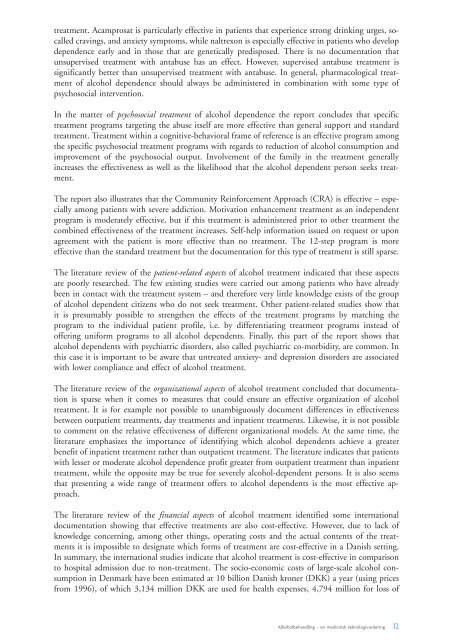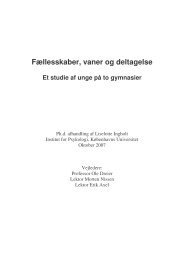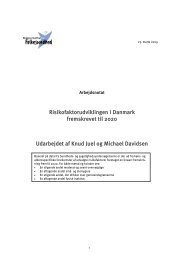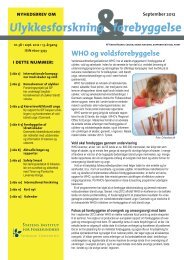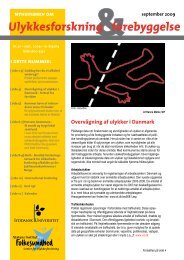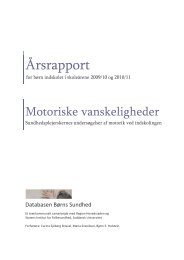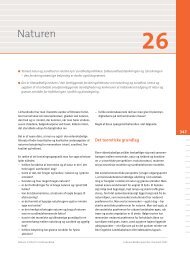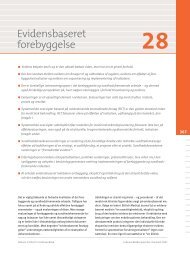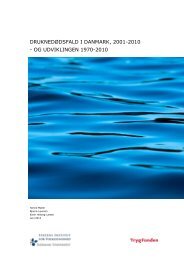ALKOHOLBEHANDLING - Statens Institut for Folkesundhed
ALKOHOLBEHANDLING - Statens Institut for Folkesundhed
ALKOHOLBEHANDLING - Statens Institut for Folkesundhed
Create successful ePaper yourself
Turn your PDF publications into a flip-book with our unique Google optimized e-Paper software.
treatment. Acamprosat is particularly effective in patients that experience strong drinking urges, socalled<br />
cravings, and anxiety symptoms, while naltrexon is especially effective in patients who develop<br />
dependence early and in those that are genetically predisposed. There is no documentation that<br />
unsupervised treatment with antabuse has an effect. However, supervised antabuse treatment is<br />
significantly better than unsupervised treatment with antabuse. In general, pharmacological treatment<br />
of alcohol dependence should always be administered in combination with some type of<br />
psychosocial intervention.<br />
In the matter of psychosocial treatment of alcohol dependence the report concludes that specific<br />
treatment programs targeting the abuse itself are more effective than general support and standard<br />
treatment. Treatment within a cognitive-behavioral frame of reference is an effective program among<br />
the specific psychosocial treatment programs with regards to reduction of alcohol consumption and<br />
improvement of the psychosocial output. Involvement of the family in the treatment generally<br />
increases the effectiveness as well as the likelihood that the alcohol dependent person seeks treatment.<br />
The report also illustrates that the Community Rein<strong>for</strong>cement Approach (CRA) is effective – especially<br />
among patients with severe addiction. Motivation enhancement treatment as an independent<br />
program is moderately effective, but if this treatment is administered prior to other treatment the<br />
combined effectiveness of the treatment increases. Self-help in<strong>for</strong>mation issued on request or upon<br />
agreement with the patient is more effective than no treatment. The 12-step program is more<br />
effective than the standard treatment but the documentation <strong>for</strong> this type of treatment is still sparse.<br />
The literature review of the patient-related aspects of alcohol treatment indicated that these aspects<br />
are poorly researched. The few existing studies were carried out among patients who have already<br />
been in contact with the treatment system – and there<strong>for</strong>e very little knowledge exists of the group<br />
of alcohol dependent citizens who do not seek treatment. Other patient-related studies show that<br />
it is presumably possible to strengthen the effects of the treatment programs by matching the<br />
program to the individual patient profile, i.e. by differentiating treatment programs instead of<br />
offering uni<strong>for</strong>m programs to all alcohol dependents. Finally, this part of the report shows that<br />
alcohol dependents with psychiatric disorders, also called psychiatric co-morbidity, are common. In<br />
this case it is important to be aware that untreated anxiety- and depression disorders are associated<br />
with lower compliance and effect of alcohol treatment.<br />
The literature review of the organizational aspects of alcohol treatment concluded that documentation<br />
is sparse when it comes to measures that could ensure an effective organization of alcohol<br />
treatment. It is <strong>for</strong> example not possible to unambiguously document differences in effectiveness<br />
between outpatient treatments, day treatments and inpatient treatments. Likewise, it is not possible<br />
to comment on the relative effectiveness of different organizational models. At the same time, the<br />
literature emphasizes the importance of identifying which alcohol dependents achieve a greater<br />
benefit of inpatient treatment rather than outpatient treatment. The literature indicates that patients<br />
with lesser or moderate alcohol dependence profit greater from outpatient treatment than inpatient<br />
treatment, while the opposite may be true <strong>for</strong> severely alcohol-dependent persons. It is also seems<br />
that presenting a wide range of treatment offers to alcohol dependents is the most effective approach.<br />
The literature review of the financial aspects of alcohol treatment identified some international<br />
documentation showing that effective treatments are also cost-effective. However, due to lack of<br />
knowledge concerning, among other things, operating costs and the actual contents of the treatments<br />
it is impossible to designate which <strong>for</strong>ms of treatment are cost-effective in a Danish setting.<br />
In summary, the international studies indicate that alcohol treatment is cost-effective in comparison<br />
to hospital admission due to non-treatment. The socio-economic costs of large-scale alcohol consumption<br />
in Denmark have been estimated at 10 billion Danish kroner (DKK) a year (using prices<br />
from 1996), of which 3,134 million DKK are used <strong>for</strong> health expenses, 4,794 million <strong>for</strong> loss of<br />
Alkoholbehandling – en medicinsk teknologivurdering 12


